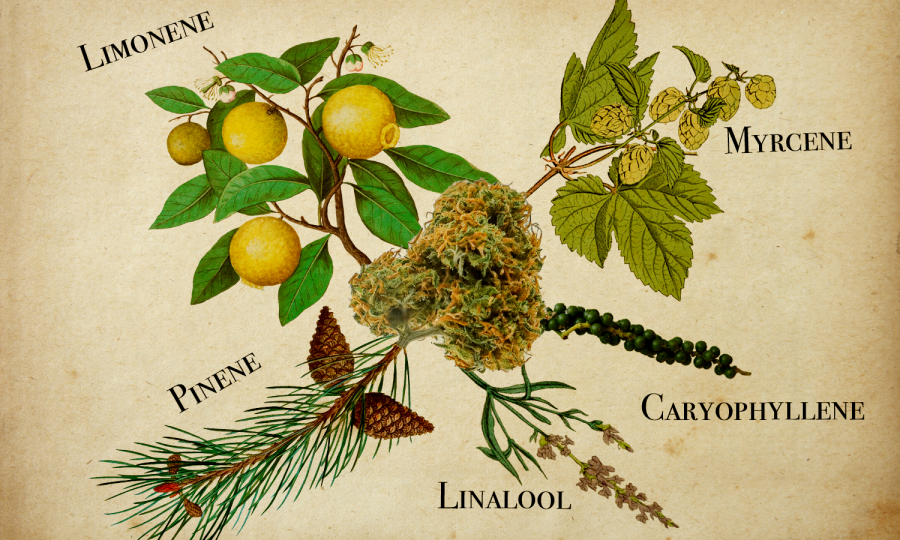The Collegian terpene guide: Just a whiff
Smells like Terpene Spirit.
October 31, 2022
You may have noticed different smells and tastes associated with varying strains of cannabis. Some are more citrusy and fruity, others are more floral and woodsy and some even have the smell and taste of diesel from the gas station. What you’ve noticed are the different terpenes present in cannabis.
The term terpene is just a more scientific way to describe the aromatic compounds present in cannabis and other plants. You may have even experienced a deliberate terpene concoction if you’ve used essential oils, such as lavender oil.
Terpenes are massively present in cannabis buds. In total, there are more than 150 different terpenes in different cannabis types (making up 3-5% of the dry mass of the bud), though most of them are in quantities too low to notice, even for the most observant of stoners.
Now, onto the next question: Why should anyone care about terpenes?
“All strains will likely contain some of each of these terpenes, and paying attention to what strains you prefer over others ultimately will be more informative than buying based on smell.”
Besides taste and smell, the terpenes present in different buds may be responsible for the differentiation in sensations, even if anecdotal.
“Think of it like a five-course meal,” said Francisco Pantoja, a plant technician for a medical grower in Boulder. “It’s the sight, the smells, the taste and the effect — it’s not just about the end result, it’s about how you get there.”
This is called the entourage effect. The entourage effect is a theory about how different cannabinoids interact along with terpenes. The basic idea is that cannabinoids (mainly delta-9 THC) interact with the effects of other compounds present in cannabis (mainly CBD but also terpenes) to produce sensations different from THC or CBD alone.
The entourage effect is mostly anecdotal with varying degrees of scientific support, so take this terpene guide with an appropriate amount of salt. With that in mind, here are five major terpenes worth considering the next time you go to the dispensary.
First up is myrcene: an earthy, herbaceous, spicy scent. This is one of the most prolific terpenes in cannabis and is also found in hops, which is why beer has a spicy, earthy, peppery fragrance in more hoppy varieties. It is found in thyme, mango, lemongrass and cloves.
“It gives an earthy, sweet and musky smell with a spicy, pepper-like taste,” Pantoja said. “It produces a sedative effect that is good for pain relief, anti-inflammation and anti-anxiety. … Well-known strains rich in myrcene would be OG Kush, Blue Dream, White Widow, Agent Orange, Grape Ape and Tangie.”
Myrcene is not the only part of what makes weed smell the way it does. Another major component is linalool.
“It smells sweet, floral and slightly peppery; with its floral flavor, too much can turn into a bitter, perfumey taste,” Pantoja said. “Its effects are strongly relaxing, similar to its expected effect when used in aromatherapy.” Linalool is more common in more floral, calming strains like Dosidos, Scooby Snacks and Zkittlez.
Next up is limonene. You’ve encountered this terpene if you’ve ever zested or peeled a lemon, orange or lime. “(It has) strong citrus smell and taste, and … linalool has therapeutic qualities, so it’s good for anxiety, depression (and) stress relief and has been used to help with chronic heartburn and acid reflux,” Pantoja said. This terpene is common in strains named after fruits or with sour in the name, such as Sour Diesel and Lemon Haze, among others like Tahoe OG.
Our next terpene is caryophyllene. “Found in cinnamon, black pepper and hops, it has a strong woody odor and is attributed with giving black pepper its smell and spicy taste,” Pantoja said.
There are some studies that claim this terpene interacts with the cannabinoid system on its own, but that research is disputed. The main effects of caryophyllene are relaxation and anxiety reduction. “Strains high in caryophyllene are White Widow, Bubba Kush, Chemdawg, GG4 and Runtz,” Pantoja said.
Finally, to round out our (by no means comprehensive) list, there’s alpha- and beta-pinene. “Alpha- and beta-pinene are very similar, but alpha is much more prominent in cannabis,” Pantoja said. “Found in pine trees and rosemary, … the taste is herbal and earthy like pine nuts. Similar to others, it is anti-inflammatory — it also improves airflow and respiratory functions.”
“It is also known to make you more alert, which, unfortunately, makes this one partly responsible for some people’s paranoid highs,” Pantoja added. Pinene is often less dominant as a terpene than the others on this list but still has strains where it shines, such as Blue Dream, Snoop’s Dream and Critical Mass.
This list is by no means complete nor is it medical advice. The goal here is to educate so anyone can go into the dispensary with more of an idea of what they like. All strains will likely contain some of each of these terpenes, and paying attention to what strains you prefer over others ultimately will be more informative than buying based on smell.
“Regardless if you are actively thinking about it or not, everything is going to affect how you feel at the end,” Pantoja added. “You want to have a full product, a full high. … It’s a multi-sensory experience — one that, start to finish, you should feel good about participating in.”
Reach Grayson Acri at cannabis@collegian.com or on Twitter @Guy1376.







